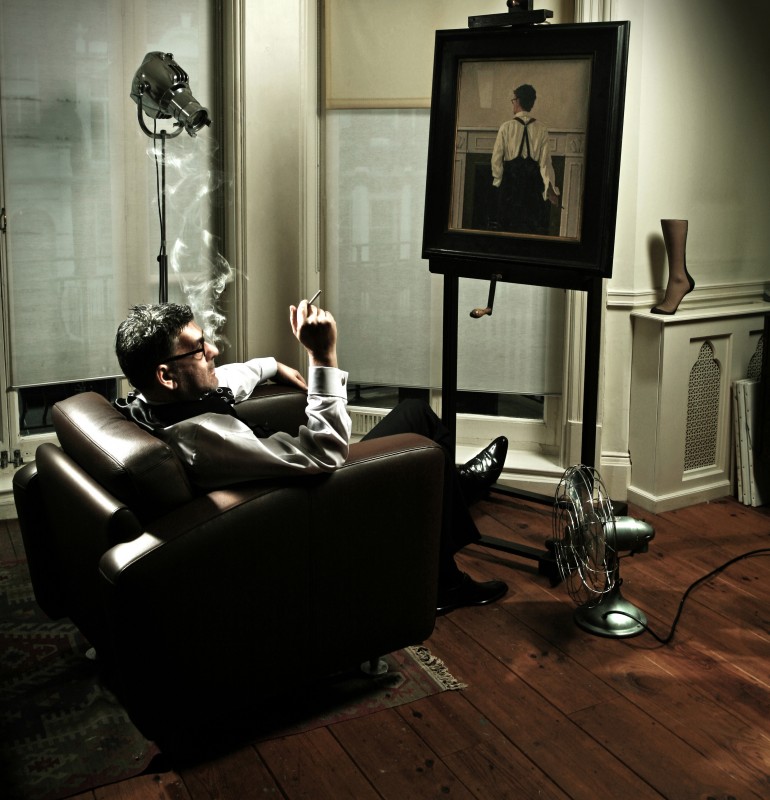Vetrianno, born Jack Hoggan, is a Methil-born Scottish painter and a modern-day artistic phenomenon, suis generis. He takes time out from his busy schedule to talk with Together.
Together: Jack, thank you for taking the time to talk to us. Starting at the beginning: You changed your name quite early – was there a particular reason for this? Are there any of your earlier ‘non-Vettriano’ works still in circulation?
JV: As people are aware, I am a self-taught artist. I never had the luxury of art school but instead I used to visit my local public gallery, Kirkcaldy Museum & Art Gallery and study the paintings. I doubt the curators can remember a skinny 30 year old with long curly hair and a moustache, but I would visit often and stay for hours to look at the magnificent collection of paintings of McTaggart and The Glasgow Boys trying to work out how they did it. I trained myself to paint by copying other artists. That was how I learned, by copying. I put all these different styles in a pot and there was a certain alchemy that took place and it created my individual style. I started painting at 21, in 1973, and it wasn’t until 1989 that I decided to see if I could make a living and changed my surname– it is my mother’s maiden name. It was a way of moving on from my early work and starting fresh. There are probably lots of Hoggan’s hanging on the walls of the houses in my local town but I haven’t kept track of them.
Your latest exhibition, Days of Wine and Roses, attracted more than 45,000 visitors in its five-week run – quite a feat. Are there any plans to take it ‘on the road’?
Thank you. I was absolutely thrilled that so many people came out to see it, especially as it was in my home town. Days of Wine and Roses will be exhibited in a brand new gallery called ‘Heartbreak’ in London this autumn from 30th September to 31st October.
Sir Terence Conran once compared you favourably to Edward Hopper, for your aptitude for ‘doing something different’. Do you consciously strive for this, or are you still the Jack Vettriano who painted The Singing Butler all those years ago?
I paint because I have stories to tell. Painting allows me to be the master of ceremonies, narrator and leading man all at once if I want or to disappear into the background as the unseen voyeur. I have described my work as “a cross between old railway posters and the covers of pulp fiction novels” and I paint what pleases and moves me. Like any other artist, my style changes and develops over the years. I painted The Singing Butler in 1992 and what inspires me now is very different. I’m very proud of The Singing Butler and how successful it has been but I prefer the interiors work more.
‘I painted The Singing Butler in 1992 and what inspires me now is very different. I’m very proud of The Singing Butler and how successful it has been but I prefer the interiors work more.’
Despite public acclaim that borders on adoration, the art world and its critics still don’t seem to ‘get’ what sort of appeal a Vettriano painting has. If the general public can understand it, is there a problem?
I am an outsider in so far as I do not have one connection in the art world. I taught myself to paint in a back room and maybe some critics think that is a bad pedigree. But so be it. I am grateful that the public continue to enjoy my work and that’s it. I think it’s best to take what you get with grace and humility.
I mentioned The Singing Butler earlier. One thing has always puzzled me – the title. Rather than singing, he seems to be cowering from a pretty fierce seaside wind. So why the title?
The couple are dancing but there isn’t a gramophone or string quartet to accompany them. That’s why the butler is singing – he provides the music so they can dance. If you have ever been to Scotland, you’ll know that the wind is fierce but it doesn’t stop you from doing anything!
You have been accused – often, it seems – of painting chauvinistic themes, women as playthings for men. I feel that the women have all the power. One of my personal favourites, Only the Deepest Red, clearly shows a woman who is very self-assured. How do you respond to the ‘chauvinist’ tag?
The ‘chauvinist’ tag has always puzzled me because I couldn’t live without women. They are the stronger sex. I’m indebted to them for providing me with inspiration for all my work and I have always sought the company of women over men. This is not purely a sexual endeavour; as companions, they possess a range of qualities that far outweigh those of mere men.
Many of the women in your paintings are of a similar type or stature. Who are your muses?
My muses are friends, lovers and women who have influenced my life. I have always thought it was better to paint a woman in her thirties if only because she has a better grasp of the world I am trying to create. I don’t hide from the fact that I only paint women who I find attractive and my ideal is brunette, about 5ft 4in with shapely legs. There have been three women whom have played an important role in my life, whom gave me courage, ideas and affection. I don’t find it at all difficult to find models, but that’s very different from a muse. With a model, you have the idea, and then you get them to pose. With a muse it’s more about their personality, life experiences, and that’s when I really start to feel inspired.
‘I don’t hide from the fact that I only paint women who I find attractive and my ideal is brunette, about 5ft 4in with shapely legs.’
What do you think of Banksy’s take on The Singing Butler – the one paraphrasing yours with people clearing up nuclear waste in the background?
I was flattered that someone such as Banksy would consider me worthy of attention.
Many of your early paintings seem to be evocative of a certain era – the 40s and 50s. Was there a reason, or did you just like the ‘feel’ of that era?
I can remember growing up seeing my parents put on their suit and dress and get ready for a night out. The gramophone would be playing and I just thought they were the most glamorous people I had ever seen. It’s probably why I am so keen on the television series Mad Men, because it depicts an era when women still wore stockings every day and knew the power of red lipstick over men.
Lastly, the question we ask of all our respondents: What, would you say, is the secret to your success?
I worked hard, and I must have got the timing right. There’s something about my work that seems to make people engage with it, which is great as I really only ever paint what interests me. I was lucky too that my pictures lend themselves to reproduction. The birthday cards and posters have given me exposure to a vast audience – including top-level collectors – who might never have heard of me otherwise.
Visit more of Jack Vettriano’s work here.







